AAP data released: How serious are children’s COVID-19 cases?
- Aspirin: Study Finds Greater Benefits for These Colorectal Cancer Patients
- Cancer Can Occur Without Genetic Mutations?
- Statins Lower Blood Lipids: How Long is a Course?
- Warning: Smartwatch Blood Sugar Measurement Deemed Dangerous
- Mifepristone: A Safe and Effective Abortion Option Amidst Controversy
- Asbestos Detected in Buildings Damaged in Ukraine: Analyzed by Japanese Company
American Academy of Pediatrics (AAP) data released: How serious are children’s COVID-19 cases?
AAP(American Academy of Pediatrics) data released: How serious are children’s COVID-19 cases? We have been keeping a close eye on the severity of children infected with COVID-19.
The reason is naturally that the children at home need activities. If you wear a mask, you cannot engage in vigorous activities; if you don’t wear a mask, there is a risk of infection.
So, where to go during the summer vacation, what is the scope of activities, whether to call friends, and what are the preventive measures? As well as whether to start a school, whether to make a shuttle bus, what kind of mask to wear, whether to make an appointment with the children, etc., these must be determined according to the epidemic situation and the degree of tolerance in case of infection.
More importantly, a certain proportion of serious adverse events occurred during vaccination. Acute myelitis and Guillain-Barré syndrome associated with traditional vaccines, fatal venous thrombosis associated with adenovirus vaccines, and myocarditis associated with mRNA vaccines are all chilling.
Knowing the severity of children infected with COVID-19 will help make accurate judgments about whether to vaccinate.
However, it is a pity that most of the data in various countries are concentrated on the elderly and susceptible people; after all, these high-risk groups are more likely to be infected and die from diseases, so naturally they have attracted much attention.
Relatively speaking, there is very little data on children.
We have systematically interpreted Nature’s discussion of the pros and cons of child vaccination. But there is still no data we want.
The United Kingdom has also reported the deaths of children with COVID-19 cases in the country, showing a very low rate of severe illness and mortality, but this set of data is data from the year before the COVID-19 pandemic in the United Kingdom. And now there is a Delta mutant strain, so this set of data can no longer be used to make current decisions.
For the children, you have to dig up data. . .
Hard work pays off. Today, we finally found the most comprehensive summary of COVID-19 infections in children, from the American Academy of Pediatrics, and the cases are summarized until July 29, 2021.
This set of data is very detailed, and after reading it, I immediately feel that my eyes are much brighter; and it is very different from the previous data. When I read it, I feel cold behind.
Because just this past weekend, in the playground we went to, almost no one wore masks, and there were many more people than in 2019; of course, it was mainly children who came to play. It seems that there is no such thing as the COVID-19 virus.
Combining the data from American Academy of Pediatrics, we find that the United States has been too negligent about children’s cases.
First look at the basic information behind this set of data.
1) The age of the children in this set of data.
The ages of children reported by American Academy of Pediatrics are based on reports from various states. Most states are 17 years and younger, and some states are 19 years and younger. So the children in the data below are also in this age group.
2) Vaccination status.
The United States currently offers vaccinations for children over 12 years of age.
According to the CDC, out of approximately 25 million American children between the ages of 12 and 17, approximately 10.9 million (43.6%) have received at least one dose of the vaccine.
Second, look at the summary of this set of data.
At present, the United States has reported 4.19 million cases of COVID-19 in children, accounting for 14.3% of all U.S. cases.
According to the census just completed in the United States, there are 73 million children (under the age of 18) in the United States, accounting for 22% of the total population.
Based on this calculation, approximately 5.6% of American children have been infected with COVID-19.
Among them, in the past week, there were 71,000 cases of COVID-19 in children in the United States, an increase of 19% from the previous week.
What we are most concerned about is how unfortunately children are infected with COVID-19 and how serious their illnesses are.
As you can see from the screenshot below, among children infected with COVID-19, 0.1%-1.9% need to be hospitalized, and 0.00%-0.03% die from illness.
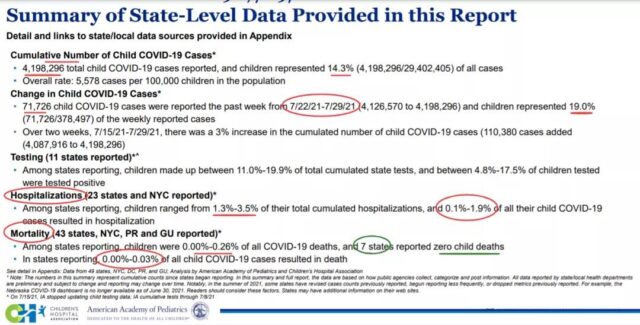
Next, let’s take a look at this set of data in detail.
Judging from the situation in each state, California (CA) reports much higher numbers of children with COVID-19 cases than other states. The state of Virginia (VA) where we are located is also near the top. Of course, this number of cases is like the number of cases in various countries, and cannot represent the severity; because the population of each state is different, and the vaccination rate is different.
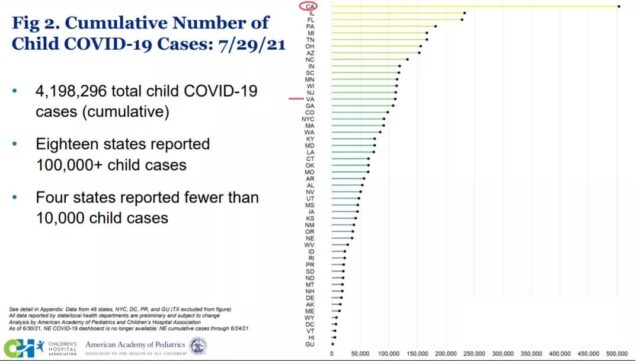
The picture below shows the proportion of children with COVID-19. It can be seen that Vermont (VT) has the highest proportion of children with infections; VA is in the middle.
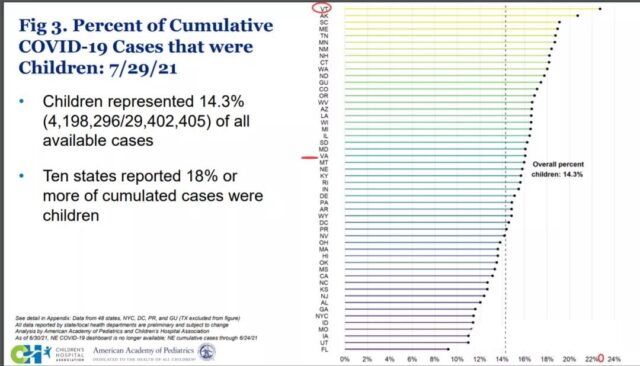
The changes in new cases of COVID-19 in children are as follows, consistent with the fluctuations in adults.
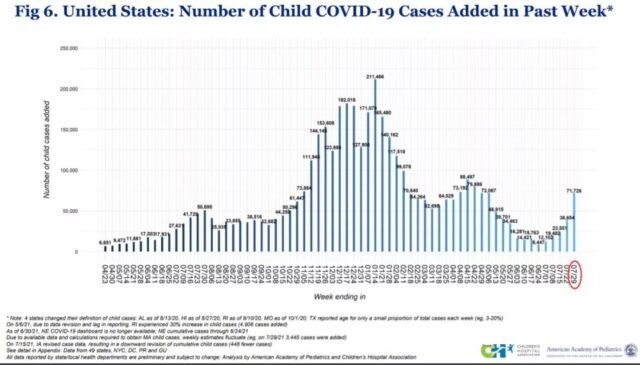
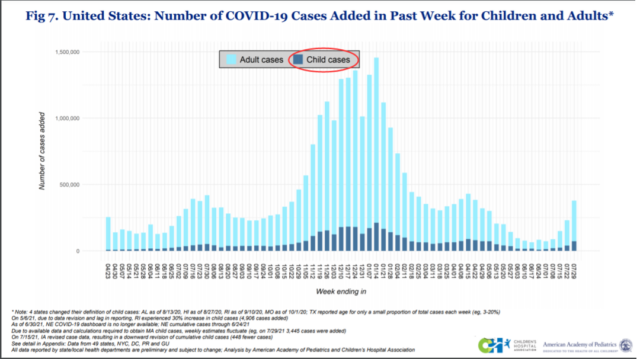
Finally, let’s look at the average infection, severe illness, and fatality rate of children with COVID-19.
We only look at the situation in the last week.
Child cases accounted for 14.3% of all cases, and cumulative cases have accounted for 5.6% of all children.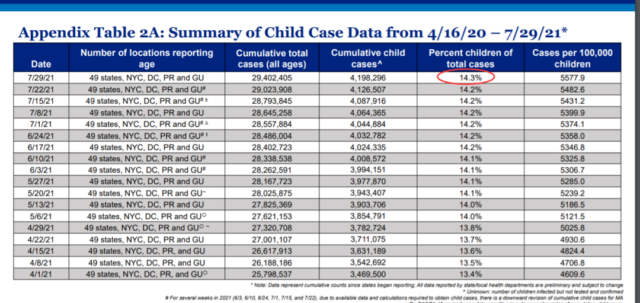
In the past week, COVID-19 cases among children in the United States requiring hospitalization accounted for 2.3% of all hospitalized cases, and the hospitalization rate was 1%. That is, for every 100 children infected with COVID-19, one is seriously ill and needs to be hospitalized.
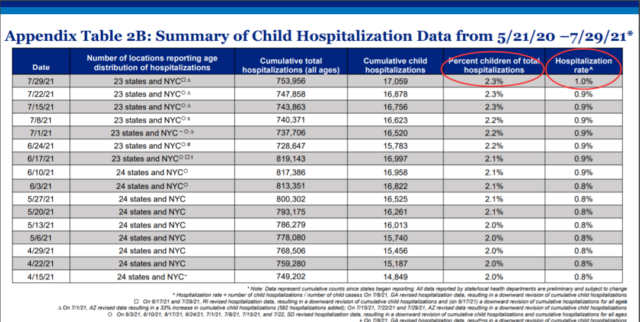
In the past week, COVID-19 deaths among children in the United States accounted for 0.07% of all deaths, with a case fatality rate of 0.01%. That is, for every 10,000 children who are infected with COVID-19, there will be one death.
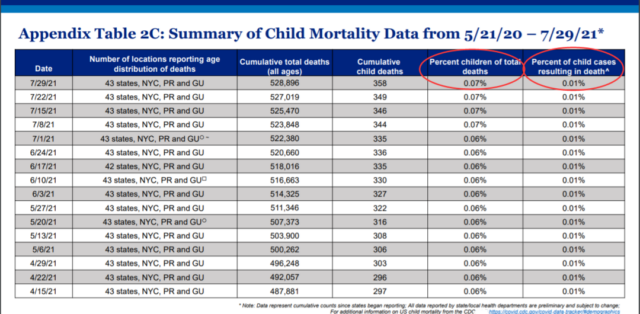
Briefly summarize this set of data:
1. As of July 29, 2021, 4.198 million children in the United States have been infected with COVID-19; child cases accounted for 14.3% of all cases and 5.6% of all children.
2. In the past week, children with COVID-19 in the United States requiring hospitalization accounted for 2.3% of all hospitalized cases, and the severe rate of children with COVID-19 was 1%.
3. In the past week, COVID-19 deaths among children in the United States accounted for 0.07% of all deaths, and the case fatality rate for children with COVID-19 was 0.01%.
Because 95% of the currently infected strains in the United States are Delta mutants, the situation in the past week basically represents the severe illness rate (1%) and fatality rate (0.01%, or 1 in 10,000) of children infected with the Delta mutant.
This set of data is very important.
Because as we discussed before, vaccination also has a certain proportion of serious adverse events.
For example, the Zhejiang Center for Disease Control and Prevention (Ref 1) reported that the incidence of serious adverse events in inactivated virus vaccines is 1 in 1 million doses; the incidence of severe thrombotic events after Johnson & Johnson adenovirus vaccination is about 1 in 1 million doses , AstraZeneca adenovirus vaccine is 3.4/1 million doses; Pfizer mRNA vaccine has a severe allergic reaction rate of 4.7/1 million doses, and Moderna vaccine is 2.5/1 million doses.
According to the UK’s previous national case study report on children with COVID-19, in the first year of the COVID-19 pandemic, a total of 25 children died of COVID-19 across the country, and most of them were children with serious underlying diseases. If you follow the previous set of data in the UK, in fact, children’s vaccination does not pay off. Because of this, the UK has not approved the vaccination of children under 16 years of age.
But the Delta mutant strain changed all of this. Children’s COVID-19 cases have also increased sharply, and once infected with COVID-19, the severe illness rate is 1%, and the case fatality rate is 1 in 10,000. With such a high rate of severe illness and mortality, the benefits of vaccination are significantly higher than the serious adverse events of vaccination.
The most important thing is that the basic infectious value (R0) of the Delta mutant strain is between 5 and 9.5. As long as the children are going to school and want to play with other children, they can hardly escape the chase of the COVID-19 virus.
Today’s interpretation comes to an end. You are welcome to provide data and information to discuss optimization strategies for fighting COVID-19.
(source:internet, reference only)
Disclaimer of medicaltrend.org
Important Note: The information provided is for informational purposes only and should not be considered as medical advice.



